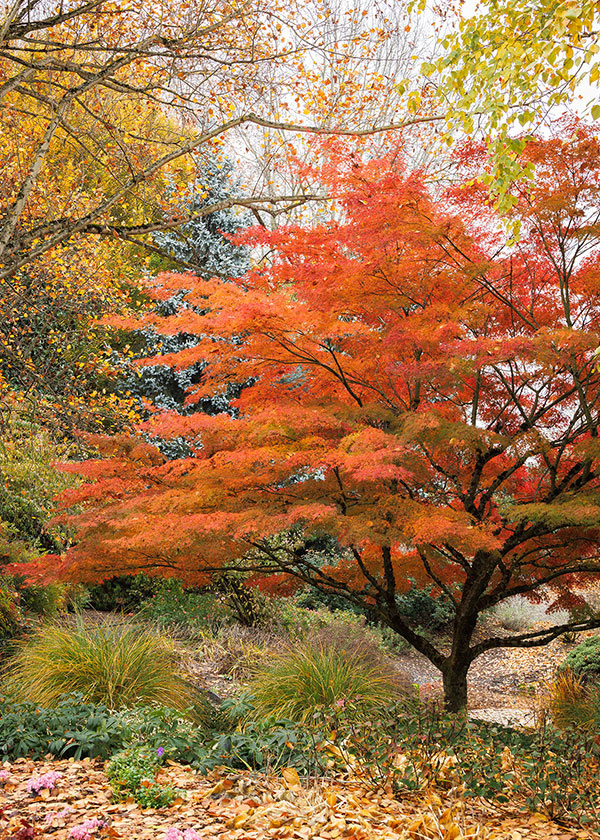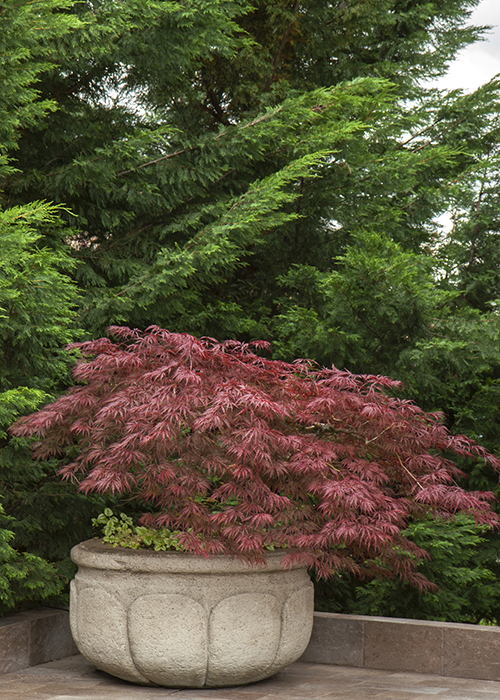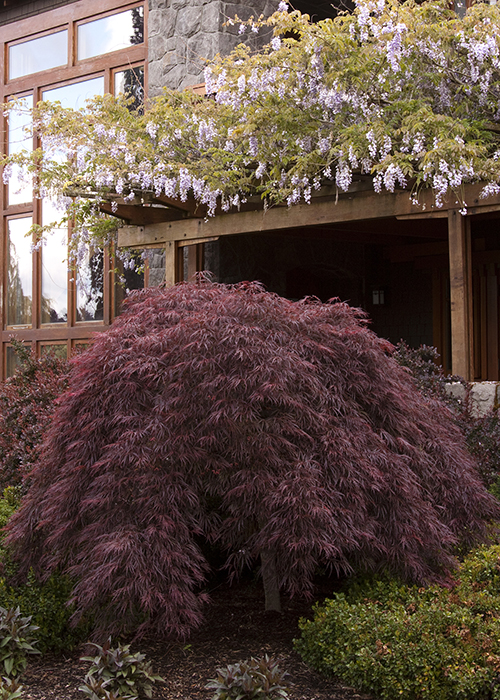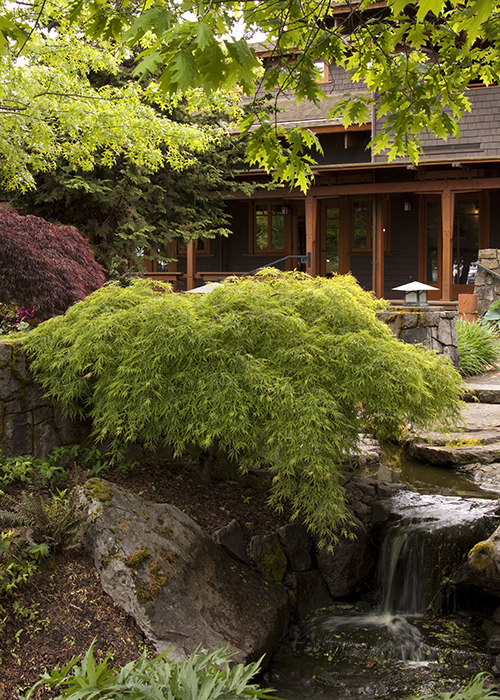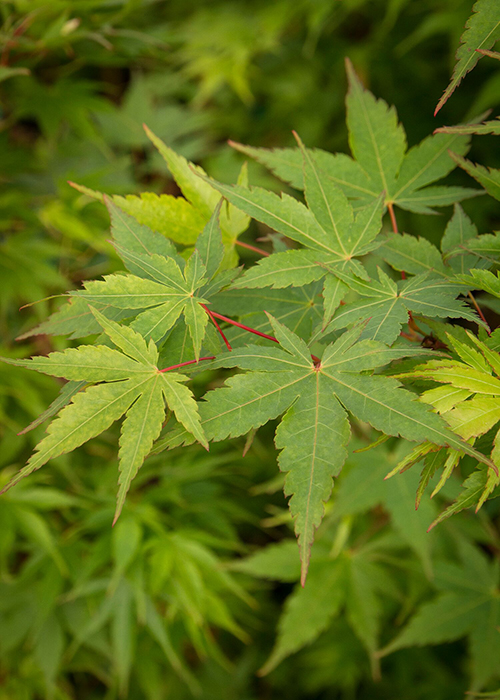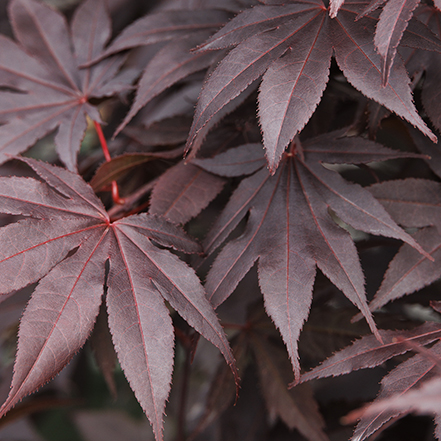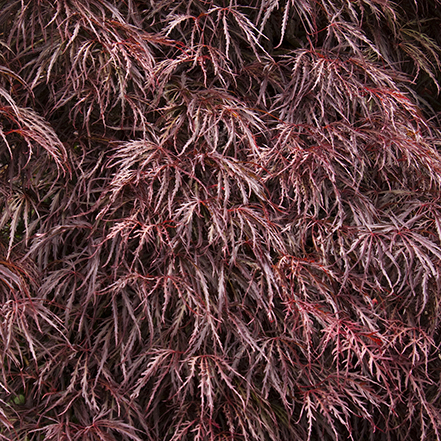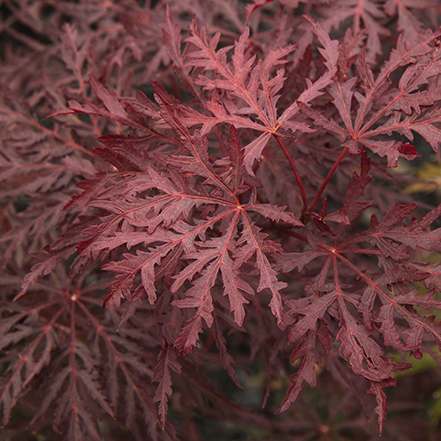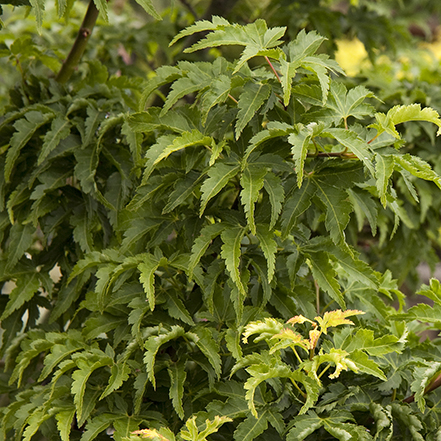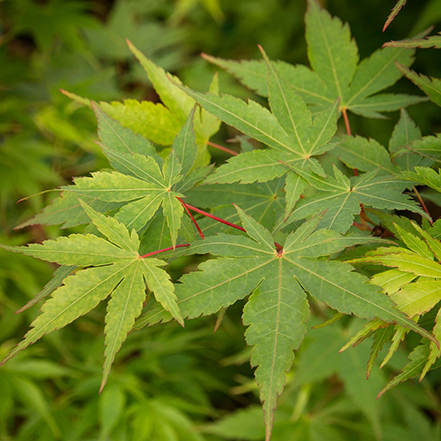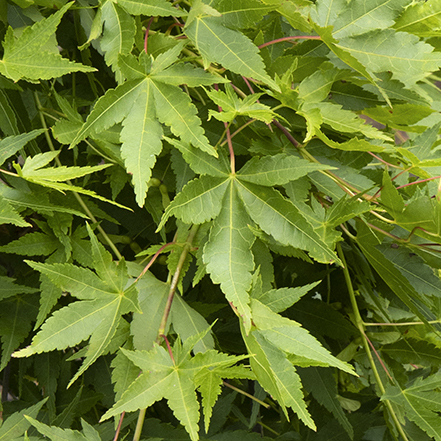With their spectacular autumn color and elegant branching patterns, Japanese maples (Acer palmatum) are beloved in gardens around the world. These plants come in a wide variety, growing anywhere from 2 to 30 feet tall, and, once established, are relatively carefree.
(Above) Seiryu Japanese Maple has fall foliage that turns an interesting purple-brown then brilliant red. Part to full sun. Up to 15' tall, 8' wide. Zones 5-8.
Selecting the right Japanese maple is made easier thanks to our guide, but what about their year-round care? We're here to walk you through a complete Japanese maple care guide so you feel confident adding one to your landscape.
Varieties and Types of Japanese Maples
As a popular ornamental tree, the Japanese maple boasts over 1,000 varieties. Monrovia grows over 25 varieties, all selected and expertly grown by our craftsmen for superior performances and aesthetics.
Here are the top characteristics that differentiate Japanese maple varieties:
- Leaf Shapes: A key distinction separates two main types of maples: Upright maples have classic lobed leaves, while dissected maples, also known as laceleaf maples, feature incredibly lacy and finely divided foliage.
- Color Palette: Japanese maples have varieties with a wide array of foliage colors, ranging from green to red to purple. Plus, their leaves often showcase a vibrant spectrum during the fall, featuring hues from fiery oranges and yellows to deep purples and greenish-gold.
- Growth Habits: Varieties range from towering trees reaching 20 feet to dwarf cultivars perfect for containers, offering options for any garden size.
Popular Cultivars
- Container Maples: Monrovia's Velvet Viking™ Japanese Maple (pictured here, Zones 4-9) is a slow-growing dwarf tree that is perfectly sized for containers. With deeply dissected dark-red leaves that turn bright red in the fall, this beauty gets up to 3' tall and 8' wide.
- Standalone Maples: If your garden is missing some height, you need a Japanese maple that "wows." Our Coral Bark Japanese Maple (Zones 5-8) does just that. This year-round showstopper is known for its red-coral bark and vibrant fall foliage. It grows up to 25' tall and 20' wide.
- Statement Maples: With so many varieties, it's no surprise that some Japanese maples make a bold statement. The Ryusen Weeping Japanese Maple (Zones 5-7) is unlike any other, with green palmate leaves that grow in weeping form, shooting straight up and then cascading down. This maple is perfect for narrow spaces. With bright yellow and orange-red fall colors, its beauty is truly one-of-a-kind.
Planting a Japanese Maple
How to Choose the Best Location for Your Japanese Maple
(Above) Crimson Queen Japanese maple is a dwarf tree with a low-branching, weeping form and delicate crimson leaves. Part to full sun. Up to 10' tall and wide. Zones 5-8.
Japanese maples thrive in conditions that mimic their native habitat—areas that offer shelter from harsh winds and protection from the afternoon sun. Most of these trees do well in Zones 5-8. An ideal spot balances light and shade, ensuring the maple's intricate leaf colors are vividly displayed without risking sunburn or stress from overexposure.
In mild climates, most Japanese maples can take full sun. In hotter climates, especially dry ones, Japanese maples will need more shade and water to prevent leaf scorch. In general, the darker the leaves, the more sun it can take.
Also, consider the Japanese maple's mature size when you're looking for a location. Make sure there's plenty of space for your maple to grow tall and wide without hitting power lines, obstructing other trees, or blocking sunlight from other plants.
Planting Process and Soil Requirements for Japanese Maples
(Above) Waterfall Japanese Maple is an improved Japanese maple variety with cascading branches and finely cut green leaves. Part to full sun. Up to 10' tall and 12' wide. Zones 5-8.
These trees thrive in any well-drained, consistently moist soil—except highly alkaline soil. Before planting, work some compost into the soil around the tree to give it plenty of nutrients, and add compost occasionally during spring and early summer. Japanese maples are heavy feeders, especially when young.
Because these maples have sensitivity to extreme heat and sunlight, summer planting may not be the best choice. Planting early in the spring or into fall is ideal for most Japanese maples. However, always consider your climate. Late fall in the South is very different from the Northeast. Don't plant in late fall if a hard freeze is in the forecast—that can kill an unestablished tree.
How to Plant a Japanese Maple:
- Dig a hole three times the width of the root ball but not as deep. Position the tree in the hole so it sits slightly above the soil line.
- Mix in slow-release fertilizer into the hole and backfill it.
- Water thoroughly.
- Mulch around the tree, but be sure not to pile mulch against the trunk.
How to Care for a Mature Japanese Maple
(Above) Coral Bark Japanese Maple has red-coral bark on young branches that intensifies in winter. Part to full sun. Up to 25' tall, 20' wide. Zones 5-8.
Watering and Feeding Requirements
Newly planted Japanese maples need plenty of water to establish themselves. Water your recently transplanted maple every 1-3 days after planting, and gradually reduce the frequency to just once per week during the first growing season. You never want your tree sitting in water-logged soil, so adjust watering as needed during wet weather or to accommodate your soil. In its second and third years of growth, monitor its moisture levels and water as needed; your Japanese maple will appreciate evenly moist soil.
For mature plants, the soil should be uniformly moist. In many climates, regular precipitation is enough to keep these plants sufficiently watered. Established Japanese maples are fairly drought tolerant but will need to be watered during periods of extreme heat and no rain or after applying fertilizer.
When it comes to feeding, a balanced slow-release fertilizer applied once in spring supports healthy growth without overwhelming the tree. Mature trees will probably not need any extra fertilization.
Disease and Pest Control
Japanese maple trees can be susceptible to certain diseases and pests, such as tar spot, verticillium wilt, and aphids. Regularly inspect the leaves, branches, and stems for signs of distress if you want to catch (and stop) any issues. For diseases like tar spot, which manifests as black spots on the leaves, removing and disposing of infected leaves helps prevent the spread of the disease. For aphids, try using neem oil or insecticidal soap to control aphid populations without resorting to harsh chemicals. Verticillium wilt is a soil-born disease that leads to branches dying from the tips inward, often while others look fine. If you are concerned your maple might have verticillium wilt, contact a professional landscaper or arborist.
Pruning Techniques
The best time to prune your Japanese maple is in late winter when the plant is dormant. However, fine pruning (done for aesthetic purposes) is best done in the late spring after the leaves come out.
To prune this tree, focus on removing dead or damaged branches, mostly on the interior of the tree, as well as any branches that rub against each other. This will help improve air circulation and light penetration throughout the canopy. Make clean cuts back to lateral branches or buds for the best results, and avoid trying to entirely reshape your tree—you might end up with some glaring holes.
Less is more when it comes to pruning Japanese maples, so work slowly and carefully to get rid of dead branches, then let your tree be!
Top-Performing Varieties of Japanese Maples
Bloodgood
Japanese Maple
Burgundy-red foliage transforms into brilliant scarlet in fall, and distinctive red-black bark adds striking visual interest during the winter. An ideal choice for small gardens, patios, and entryways, lending an elegant touch to any space. This hardy Japanese maple variety exhibits excellent sun tolerance. Part to full sun. Up to 20' tall, 15' wide. Zones 5-8.
Crimson Queen
Japanese Maple
This dwarf tree features a graceful, weeping form with low-branching limbs. Its foliage maintains a lovely crimson hue throughout summer and transitions to a vibrant scarlet in autumn. Thrives in cooler regions, where sunlight enhances its color, but prefers a bright dappled shade in other areas. Perfect for container planting. Part to full sun. Up to 10' tall and wide. Zones 5-8.
Velvet Viking™
Japanese Maple
This dwarf variety showcases low, spreading branches that gracefully drape in a beautifully mounded form. Its foliage, deeply dissected and richly red, retains its color through the growing season, intensifying into vibrant red hues as autumn sets in. This tree is exceptionally cold-tolerant and makes for an outstanding specimen in any setting. Part to full sun. Up to 3' tall, 8' wide. Zones 4-9.
Shishigashira
Japanese Maple
This compact, shrubby tree stands out with its heavily curled green leaves that transform into striking purple-red hues with intricate orange-red patterns. Highly favored for bonsai, as a container specimen, and in small gardens, its highly sculptural form only grows more captivating with age. Part to full sun. Up to 15' tall, 10' wide. Zones 5-8.
Coral Bark
Japanese Maple
This stunning small tree features brilliant red-coral bark on its young branches, with its color intensifying notably during the winter. Its deeply cut, pale green leaves are adorned with attractive red margins, transitioning to a vibrant golden yellow come fall. Part to full sun. Up to 25' tall, 20' wide. Zones 5-8.
Ryusen Weeping
Japanese Maple
This extraordinary variety stands apart with its unique characteristics. While its green palmate leaves are typical of upright varieties, 'Ryusen' surprises with its weeping form that gracefully cascades downward. Foliage turn bright yellow and orange-red in the fall. Part to full sun. Up to 20' tall, 6' wide. Zones 5-7.
Additional Questions about Japanese Maple Care
Can you overwater a Japanese maple?
Yes, you can overwater a Japanese maple. Overwatering leads to problems like root rot and wilting or yellowing leaves. To avoid overwatering your Japanese maple, follow these tips:
- Water deeply, but infrequently: Allow the top inch or two of soil to dry out before watering again. You can stick your finger in the soil to check for moisture.
- Ensure good drainage: Make sure your maple is planted in well-draining soil and a pot with drainage holes.
- Consider sunlight: Maples in full sun will need more water than those in shade.
How do you take care of a Japanese maple in the summer?
During summer, keep your Japanese maple happy by giving it consistent moisture. Deep watering, especially for young trees, is key. Mulch around the base to retain moisture and regulate soil temperature. Some afternoon shade, especially for full-sun varieties, is great during the hottest part of the day. Avoid stressing the tree with transplanting or heavy pruning during the summer.
How do you rejuvenate a Japanese maple?
Does your Japanese maple look a little droopy or less colorful? Here are some things you can try:
- Pruning: Prune lightly in late winter or early spring to remove dead, diseased, or overcrowded branches. This promotes healthy growth and improves air circulation.
- Fertilization: Apply a balanced fertilizer formulated for acid-loving plants in early spring before new growth appears. Avoid over-fertilizing.
- Sunlight assessment: Is your tree getting the right amount of sunlight? Some varieties might benefit from a bit of afternoon shade during the hottest summer months.
Remember: Patience is key! Rejuvenating a Japanese maple takes time and consistency.
Why are my Japanese maple leaves turning brown and curling?
Brown and curling leaves on your Japanese maple can be caused by a few factors, all related to stress on the tree. Here are the most common culprits:
- Underwatering: This is a frequent cause. Japanese maples prefer moist, well-drained soil. If underwatered, especially during hot weather, the leaves will dry out, turn brown, and curl at the edges.
- Overwatering: While less common, overwatering can also cause browning and curling. Soggy soil suffocates roots, hindering their ability to absorb water, leading to wilting and browning despite seemingly plentiful water.
- Excessive sun exposure: Some Japanese maple varieties can tolerate full sun, but others prefer some afternoon shade. If your tree gets intense afternoon sun during the summer, the leaves may scorch, turn brown, and curl at the edges.
- Pests or diseases: Less likely, but insect infestations or fungal diseases can also damage leaves, causing browning and curling.
If by the time you reach fall the leaves have gotten some crispy edges due to a harsh summer or some missed watering, don't worry! As long as the leaves were healthy for most of the year, the tree will drop its leaves as normal and start anew the following spring.
Here's what you can do to diagnose the issue:
- Check the soil moisture: Stick your finger in the soil. If it's dry several inches down, underwatering is likely. If soggy, overwatering might be the culprit.
- Consider sun exposure: Observe how much sun your maple receives, especially in the afternoon.
- Look for signs of pests or diseases: Examine the leaves for insects or unusual spots or growths that could indicate disease.
Get More Japanese Maple Info and Plant Care Guides
- Sign up for the Grow Beautifully Newsletter. You'll get gardening tips, design advice, free digital guides, and live webinar invites. Plus, new, exclusive plant information delivered straight to your inbox twice a month.
- Top Tips to Select the Right Japanese Maple
- 10 Facts Every Japanese Maple Lover Needs to Know
- Video: How to Plant a Japanese Maple
- 10 Dwarf Japanese Maples to Accent Your Landscape
- Unusual Types of Japanese Maples
- Hibiscus Care Guide
- Conifer Care Guide
- Boxwood Winter Care
- Azalea Care Guide
- Hydrangea Care Guide
- Top 10 Tips for Planting in Summer
- How to put Hydrangeas to Bed for Winter
- Our Top 10 Gardening Tips
- Guide to Pruning Flowering Shrubs
- How and When to Prune Hydrangeas
- Pruning Ornamental Grasses
- How and When to Prune Lavender
- Check out the "Garden Tips" section of the blog. Here there are care guides and garden tips on a wide array of plants.





